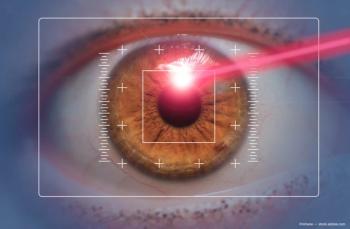
Positive results seen in multifocal ablation study for hyperopic presbyopia
San Francisco-Multifocal wavefront-guided ablation with CustomVue (Advanced Medical Optics [AMO]/VISX) for hyperopic presbyopia is associated with favorable safety, stability, and high patient satisfaction with vision, according to the 1-year results of an international treatment trial.
San Francisco-Multifocal wavefront-guided ablation with CustomVue (Advanced Medical Optics [AMO]/VISX) for hyperopic presbyopia is associated with favorable safety, stability, and high patient satisfaction with vision, according to the 1-year results of an international treatment trial.
The trial has enrolled 82 eyes of 49 patients. Among patients seen at 1 year, 100% had achieved uncorrected visual acuity (UCVA) of 20/25 at distance and J3 at near while 88% were simultaneously seeing 20/25 at distance and J1 at near without correction. Contrast sensitivity remained within age normal limits, and achieved manifest refractive spherical equivalent (MRSE) was within 0.5 D of emmetropia in 80% of eyes, explained W. Bruce Jackson, MD, at the annual meeting of the American Society of Cataract and Refractive Surgery.
The 82 eyes in the study had preoperative sphere values ranging from +0.50 to +3.50 D with a mean of +1.66 D, and cylinder of up to +1.50 D with a mean of +0.43 D.
The patients ranged in age from 47 to 68 years with an average of 56 years and two-thirds were women.
LASIK was performed bilaterally in most patients with no nomogram adjustments or re-treatments in the series. The presbyopic correction was pupil size-dependent. The Amadeus microkeratome (AMO) was used for all flap creation, and 18 of the treatments were performed with iris registration technology.
The distance UCVA results for monocular testing showed that only about 40% of eyes could see 20/40 or better preoperatively. By 1 month, 42% of eyes achieved UCVA of 20/20 or better and 92% could see 20/40 or better. The results improved over time. By 12 months, 76% of 41 evaluated eyes had distance UCVA of 20/20 or better and 91% could see 20/25 or better.
"These outcomes are as good as any that can be achieved today with wavefront-guided hyperopic treatment," Dr. Jackson said.
Continued improvement
Uncorrected monocular near vision was J5 or better in only 2% of eyes preoperatively. At 1 month, 70% could read J1 without correction and 92% of eyes were J3 or better. The 1-year results showed 61% of eyes could read J1 or better and 85% were at J3 or better.
Newsletter
Don’t miss out—get Ophthalmology Times updates on the latest clinical advancements and expert interviews, straight to your inbox.
















































.png)


